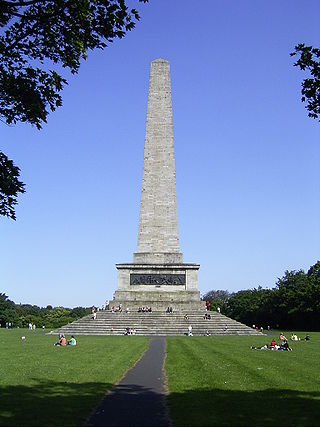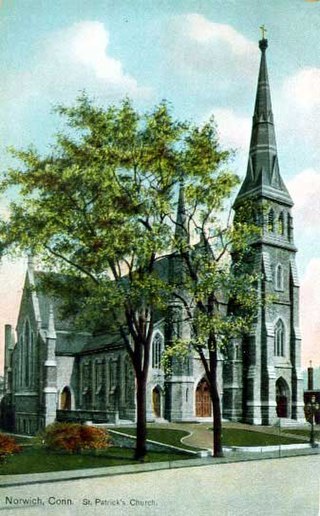
The River Liffey is a river in eastern Ireland that ultimately flows through the centre of Dublin to its mouth within Dublin Bay. Its major tributaries include the River Dodder, the River Poddle and the River Camac. The river supplies much of Dublin's water and supports a range of recreational activities.

The Ha'penny Bridge, known later for a time as the Penny Ha'penny Bridge, and officially the Liffey Bridge, is a pedestrian bridge built in May 1816 over the River Liffey in Dublin, Ireland. Made of cast iron, the bridge was cast in Shropshire, England.
The year 1899 in architecture involved some significant events.
The year 1846 in architecture involved some significant architectural events and new buildings.

James Gandon was an English architect best known for his work in Ireland during the late 18th century and early 19th century. His better known works include The Custom House and the surrounding Beresford Place, the Four Courts and the King's Inns in Dublin and Emo Court in County Laois.

O'Donovan Rossa Bridge is a road bridge spanning the River Liffey in Dublin, Ireland, which joins Winetavern Street to Chancery Place and the north quays.

Father Mathew Bridge is a road bridge spanning the River Liffey in Dublin, Ireland, which joins Merchants Quay to Church Street and the north quays. It occupies the approximate site of the original and for many years the only Bridge of Dublin, dating back to the 11th century.

Asher Benjamin was an American architect and author whose work transitioned between Federal architecture and the later Greek Revival architecture. His seven handbooks on design deeply influenced the look of cities and towns throughout New England until the Civil War. Builders also copied his plans in the Midwest and in the South.

Gridley James Fox Bryant, often referred to as G. J. F. Bryant, was a Boston architect, builder, and industrial engineer whose designs "dominated the profession of architecture in [Boston] and New England." One of the most influential architects in New England, he designed custom-made houses, government buildings, churches, schoolhouses, and private residences across the United States, and was popular among the Boston elite. His most notable designs are foundational buildings on numerous campuses across the northeastern United States, including Tufts College, Bates College, and Harvard College. One of the pioneers of modern architecture in America, he received the most commissions in New England during the height of his career. He is also the most commissioned architect in Boston history.

Patrick Charles Keely was an Irish-American architect based in Brooklyn, New York, and Providence, Rhode Island. He was a prolific designer of nearly 600 churches and hundreds of other institutional buildings for the Roman Catholic Church or Roman Catholic patrons in the eastern United States and Canada, particularly in New York City, Boston and Chicago in the later half of the 19th century. He designed every 19th-century Catholic cathedral in New England. Several other church and institutional architects began their careers in his firm.
The year 1802 in architecture involved some significant events.

Benjamin Dean Wyatt (1775–1852) was an English architect, part of the Wyatt family.

The Wellington Monument, or sometimes the Wellington Testimonial, is an obelisk located in the Phoenix Park, Dublin, Ireland.

Francis Johnston was an Anglo/Irish architect, best known for building the General Post Office (GPO) on O'Connell Street, Dublin.
Events from the year 1816 in Ireland.

The Dublin quays refers to the two roadways and quays that run along the north and south banks of the River Liffey in Dublin, Ireland. The stretches of the two continuous streets have several different names. However, all but two of the names share the same "quay" designation. The quays have played an important part in Dublin's history.

Spring Garden Street Bridge is a highway bridge in Philadelphia, Pennsylvania. It crosses the Schuylkill River below Fairmount Dam and connects West Philadelphia to the Philadelphia Museum of Art and Benjamin Franklin Parkway. It is the fourth bridge at this location.

James Murphy, FAIA, (1834–1907) was an Irish-American architect active in late-nineteenth- and early twentieth-century New England, who designed numerous Roman Catholic churches and related structures.
James Savage was a British architect, based in London. His works included the Richmond Bridge in Dublin, and St Luke's Church, Chelsea, a pioneering work of the Gothic Revival. He was architect to the Honourable Society of the Middle Temple, and carried out restoration work at Lincoln Cathedral and St Mary-le-Bow. In 1836 he published a pamphlet in which he attacked the slavish imitation of historical styles.

Richard Bond (1798–1861) was an early American architect who practiced primarily in Boston, Massachusetts.
















